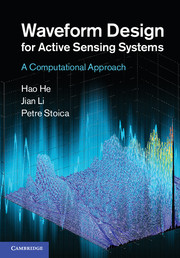Book contents
- Frontmatter
- Contents
- Preface
- Notation
- Abbreviations
- 1 Introduction
- Part I Aperiodic correlation synthesis
- Part II Periodic correlation synthesis
- Part III Transmit beampattern synthesis
- Part IV Diverse application examples
- 16 Radar range and range–Doppler imaging
- 17 Ultrasound system for hyperthermia treatment of breast cancer
- 18 Covert underwater acoustic communications – coherent scheme
- 19 Covert underwater acoustic communications – noncoherent scheme
- References
- Index
17 - Ultrasound system for hyperthermia treatment of breast cancer
from Part IV - Diverse application examples
Published online by Cambridge University Press: 05 August 2012
- Frontmatter
- Contents
- Preface
- Notation
- Abbreviations
- 1 Introduction
- Part I Aperiodic correlation synthesis
- Part II Periodic correlation synthesis
- Part III Transmit beampattern synthesis
- Part IV Diverse application examples
- 16 Radar range and range–Doppler imaging
- 17 Ultrasound system for hyperthermia treatment of breast cancer
- 18 Covert underwater acoustic communications – coherent scheme
- 19 Covert underwater acoustic communications – noncoherent scheme
- References
- Index
Summary
The development of breast cancer imaging techniques such as microwave imaging [Meaney et al. 2000][Guo et al. 2006], ultrasound imaging [Szabo 2004][Kremkau 1993], thermal acoustic imaging [Kruger et al. 1999] and MRI has improved the ability to visualize and accurately locate a breast tumor without the need for surgery [Gianfelice et al. 2003]. This has led to the possibility of noninvasive local hyperthermia treatment of breast cancer. Many studies have been performed to demonstrate the effectiveness of local hyperthermia on the treatment of breast cancer [Falk & Issels 2001][Vernon et al. 1996]. A challenge in the local hyperthermia treatment is heating the malignant tumors to a temperature above 43C for about thirty to sixty minutes, while at the same time maintaining a low temperature in the surrounding healthy breast tissue region.
There are two major classes of local hyperthermia techniques: microwave hyperthermia [Fenn et al. 1996] and ultrasound hyperthermia [Diederich & Hynynen 1999]. The penetration of microwave in biological tissues is poor. Moreover, the focal spot generated by microwave is unsatisfactory at the normal/cancerous tissue interface because of the long wavelength of the microwave. Ultrasound can achieve much better penetration depths than microwave. However, because its acoustic wavelength is very short, the focal spot generated by ultrasound is very small (millimeter or submillimeter in diameter) compared with a large tumor (centimeter in diameter on the average). Thus, many focal spots are required for complete tumor coverage, which results in a long treatment time and missed cancer cells.
- Type
- Chapter
- Information
- Waveform Design for Active Sensing SystemsA Computational Approach, pp. 259 - 266Publisher: Cambridge University PressPrint publication year: 2012



